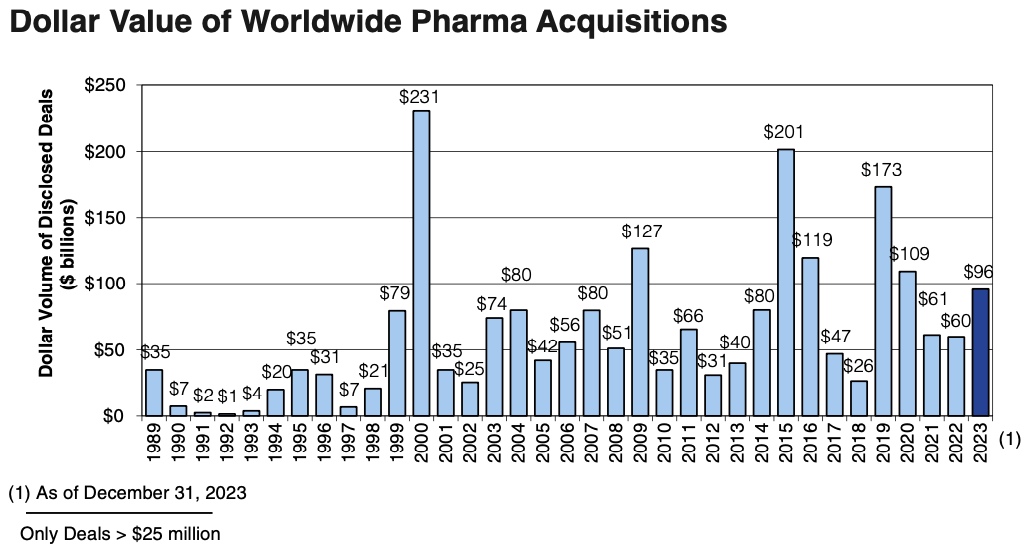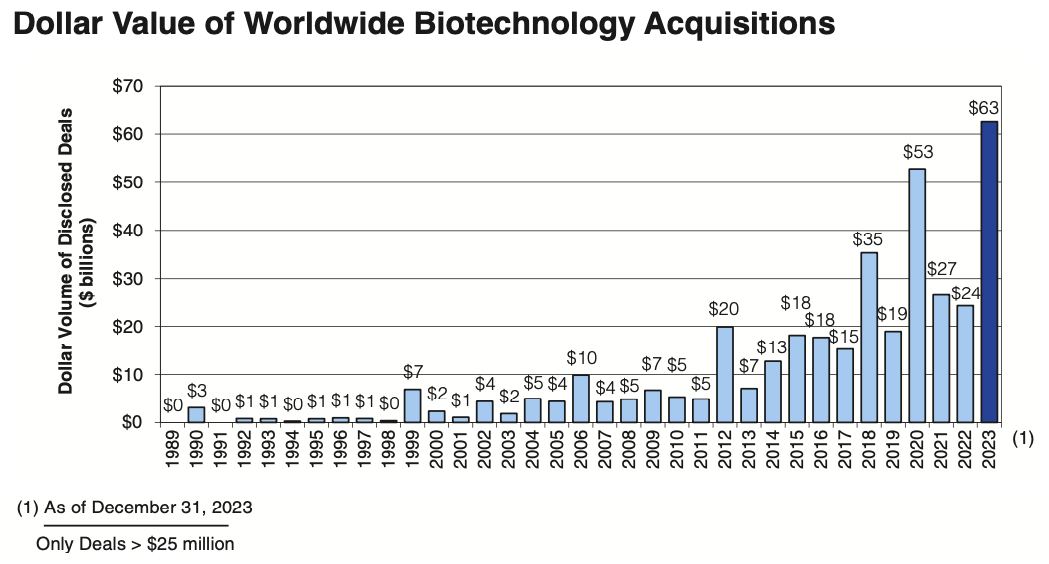Industry Business Check: Market Review Rates the Latest Full-Year Outputs
A look at pharma and biotech financing, M&A, and stock market performance in 2023—and where developments may head next as company executives continue to navigate stormy but perhaps stabilizing waters in the months ahead.

Although the pace of innovation has been strong for both pharmaceutical and biotech companies and the pace of US and European drug approvals continues to be solid, a review of financing, M&A, and stock market developments in 2023 found these trends to be volatile, with a mix of both positive and negative results. Many of these trends would seem not to make sense on the surface, but they are logical if you carefully examine the underlying drivers.
In this article, we will look at the major stock market, financing and M&A trends for pharma and biotech in 2023, the outlook for the future, and the implications for industry executives.
THE STOCK MARKET AND FUNDING
By the end of the first three quarters of 2023, the S&P 500 had increased 24.7% and the S&P Euro 350 had rose by 10.5%. This was a significant positive development, although much of the increase in the S&P 500 was driven by the seven largest technology companies.
The overall picture for the pharma industry has been mixed relative to the market.
The Young & Partners (Y&P) US BioPharma index increased by 3.7%, greatly underperforming the market. The Y&P European BioPharma index grew by 10.2%, and the Y&P Generic Pharma index spiked 23.5%.
Pharma equity issuance in 2023 was moderately below 2022. Dollar volume of equity issuance totaled $6.5 billion versus $7.5 billion in 2022. The number of offerings was also lower in 2023, with only 41 offerings versus 56 such instances the previous year.
The performance of biotech public shares has been weak. In 2023, the NBI index increased by only 4.7%, well below the market and the jump generated by pharma companies. This was a continuation of the underperformance of biotech public shares in 2022. For example, last year again experienced a suppressed number of biotech IPOs. However, there were a surprising number of secondary offerings by companies already public.
Biotech equity offerings of all types were solid in 2023, with 201 equity offerings completed versus 204 offerings in 2022. The dollar volume was also strong, with $24.8 billion from these offerings completed in 2023 versus $21.5 billion in 2022.
However, the biotech IPO market continued to be modest. Only 16 IPOs were completed in 2023, worth $3.3 billion, compared to 17 IPOs, worth $1.9 billion, in all of 2022 and the 126 IPOs, worth $26.7 billion, in 2021. This has made it much harder to raise money for private biotech companies.
Many biotechs that have had plans to go public have been facing serious funding problems, as the IPO market has been an important source of very attractive equity funds to extend these companies’ research and regulatory runways.
The drop in biotech stock market valuations have also pushed down private equity funding valuations and availability. Venture capital (VC) firms absorbed big paper losses on their existing ownership positions in private and public biotech/biopharma companies and dramatically slowed funding, except in the hot areas of technology. VC firms’ focus has been on defending their existing portfolio companies to make sure they survive the funding and IPO drought. However, there are signs that investing activity is picking up as VCs take advantage of lower valuations and because they really cannot stop investing entirely.
With many of the private biotechs running out of money, we will continue to see downsizing announcements on a regular basis. Some biotech companies will not survive and will have to shut down. This down cycle has impacted the sector many times historically, so this is not a new development in the history of the industry.
PHARMA M&A IN 2023 AND THE OUTLOOK
Acquisitions of biopharma companies by pharma have traditionally been a regular part of the landscape. Although Big Pharma companies have revived their ability to invent new drugs, they still need to supplement their own efforts with acquisitions of and collaborations with mid-sized pharma and biotech organizations. However, the companies that Big Pharma are pursuing are quite different from just a few years ago. Pharma organizations have been focusing on small-to-medium-sized pharma acquisitions, not the mega deals of old.
In 2023, 29 pharma deals, worth $95.8 billion, were completed versus 42 deals, worth $59.9 billion, in 2022. This represents a dramatic increase in dollar volume, but a major decrease in the number of deals.
Only two of the 29 deals in 2023 were of the large, mega-deal variety: Pfizer’s acquisition of Seagen for $44.5 billion and Amgen’s purchase of Horizon Therapeutics for $30.2 billion.

Big Pharma’s balance sheets and cash flows are strong in general; so, these companies have a great deal of dry powder. However, their more selective, cautious acquisition of medium-to-small pharma companies is a reflection of concerns about the overall business environment, a move away from mega deals, and access to a wide variety of other strategic asset avenues, such as biotech acquisitions, partnering, and licensing.
As of Dec. 31, 2023, the dollar value and number of pharma deals announced but not closed was quite low at $1.5 billion (seven transactions).
We expect pharma M&A this year to continue to be moderate in terms of the number of deals, with a focus on small-to-medium-sized transactions. Deals with a strong strategic rationale or a theme around adding new and growing technologies and products will continue to be pursued.
There may be one or two larger deals struck, but they are not the strategic focus of pharma companies in 2024.
BIOTECH M&A IN 2023 AND THE OUTLOOK
Last year, 79 biotech deals, worth $62.7 billion, were completed versus 45 deals, worth $24.3 billion, finalized in 2022.
This was a record level in terms of the total dollar volume and the number of deals. There was only one large transaction—the $9.6 billion acquisition of Prometheus Biosciences by Merck & Co.
The dollar value of the pipeline of biotech deals announced but not closed as of Dec. 31, 2023, was a hefty $45.2 billion (22 deals).
What is driving this trend? First of all, most of the acquisitions are being initiated by pharma companies who are aggressively looking to build their pipelines and revenues. Second, with the collapse of the IPO market, a severe reduction in equity funding, and a dramatic reduction in the share prices of biotech companies, biotechs are more willing to consider a sale of the company at an earlier stage than they were just two years ago.

What is the outlook for biotech M&A? We expect more of the same in the future driven by the same factors, with a relatively robust number and dollar volume of deals being completed over the next couple of years, along with partnering, licensing, and royalty monetization for funding and for shareholder liquidity.
M&A volume in terms of numbers of deals will continue to be strong for the rest of 2024 and beyond.
SENIOR MANAGEMENT'S APPROACH
Pharma management will be heavily focused on acquisitions where there are compelling strategic rationales and where the same results cannot be obtained internally or through licensing and strategic partnerships. However, it will be a challenging exercise, as usual, to determine what the right valuations are for each deal. With the collapse of the public market values for biotech companies and the downward repricing of private biotech companies in down rounds, matching buyer and seller expectations will continue to be a challenge.
For biotech executives, those representing private or public companies that have assets that appeal to pharma organizations should consider selling now, given M&A valuations and the high demand for deals in today’s climate.
GEOGRAPHIC CONSIDERATIONS FOR M&A
Not surprisingly, the largest volume of M&A deals in biotech in 2023 was centered in the US, with 59 of the 79 deals generated in North America. Given that the US is home to the greatest portion of biotech companies in operation, one would expect this profile.Fourteen of the remaining 20 deals were completed in Europe—the second-largest biotech industry concentration.
The geographic dealmaking picture has proven similar in the pharma sector, with 14 deals completed in the US in 2023 and six deals established in Europe.
IMPLICATIONS FOR PHARMA AND BIOTECH COMPANIES
Pharma companies will continue to enjoy attractive stock-market valuations and access to financing markets, both of which will remain stabilizing forces for the industry. Although biotech stock-market valuations are down and will take some time to recover, it is at least possible for existing public biotech companies to sell equity, and there are small signs that the IPO market for biotechwill begin a slow recovery.
This overall picture is positive for pharma companies because there is a large pool of biotech organizations available for M&A transactions, licensing, and strategic partnerships at valuations that are better than two years ago.
For biotech organizations, the key will be the quality and the maturity of their respective drug-candidate pipelines and cash needs. If a company is focused in a therapeutic area that is the subject of high strategic interest and/or is at a viable financing point, the outlook will be positive. The rest of the field will have to forge a path that is sized properly relative to how long of a runway one needs to get to a viable financing or M&A point.
For many biotech companies, it will be a matter of survival.
Peter Young is CEO and president of Young & Partners, and is a member of Pharm Exec’s Editorial Advisory Board. He can be reached at pyoung@youngandpartners.com

Cell and Gene Therapy Check-in 2024
January 18th 2024Fran Gregory, VP of Emerging Therapies, Cardinal Health discusses her career, how both CAR-T therapies and personalization have been gaining momentum and what kind of progress we expect to see from them, some of the biggest hurdles facing their section of the industry, the importance of patient advocacy and so much more.